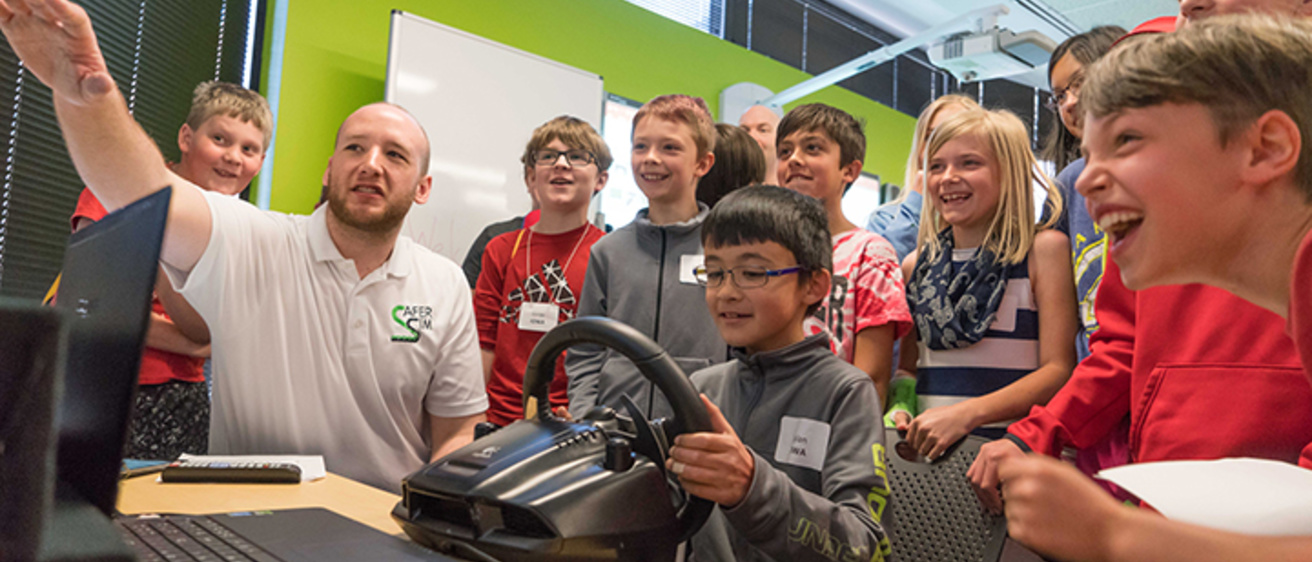By Andy Goodell
Video by Mei-Ling Shaw Williams
From elementary students’ early understanding of science and math concepts to the many post-graduate research explorations we champion, the College of Education leads the charge in STEM education.
Renowned faculty and high-caliber students collaborate, creating powerful teaching and learning opportunities. This is an environment that takes future teachers everywhere from one of the highest-tech learning classrooms in the state to the mountains of Colorado – and many other spaces in between, all on the quest to produce the best teachers possible. These are teachers who are prepared to lead in 21st-century classrooms, inspiring a joy and appreciation for STEM learning, so critical to the future of our economy and communities across the state, nation, and world.

Dave Conrads holds a black-capped chickadee during a real-world bird-banding experience for future teachers.
Our students are stimulated to think outside the box, to explore, and stretch their comfort zones – all so they can inspire future students to do the same. Both robots and a field of wildflowers possess the potential to inspire a love of and appreciation for STEM learning. Read on, and you’ll discover why the University of Iowa College of Education is recognized as a leader in STEM innovation and excellence.
STEM Advocacy
Mark McDermott (Ph.D. ‘09) spent 14 years as a science teacher before becoming STEM Coordinator for the College of Education. Today, he’s strengthening a network of around 100 STEM educators throughout the campus and Iowa to optimize STEM education statewide. This network stands to grow through the new MA in STEM Education program.
McDermott continues to spark interest in STEM careers among high school students. He leads the Topics in Education class at the Kirkwood Regional Center at the University of Iowa, where students have the opportunity to program artificially intelligent robots for a mock debate exercise.
Pre-service teachers at the college and other area institutions had the chance to have a real hands-on experience during the 2017 STEM Pre-Service Teacher Conference. Here, they were able to thoroughly explore their interests in STEM teaching and learning. They also ventured into learning about innovative approaches and opportunities in STEM education.
Our outreach doesn't end there.
The Belin-Blank Center for Gifted Education and Talent Development’s STEM Excellence and Leadership program spearheads extracurricular programming for students in grades 6-8 in science, mathematics, and integrated STEM studies in Iowa. The program recently earned nearly $2 million in funding from the National Science Foundation. This grant will allow the Belin-Blank Center to strengthen the impact of the program by examining its strengths and challenges.
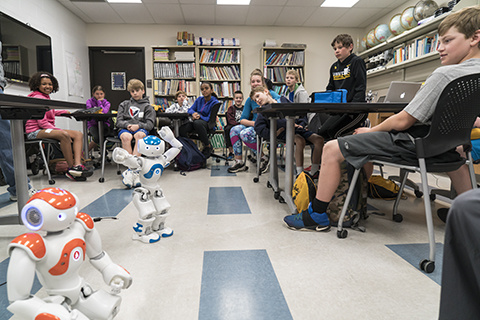
Robots encourage computer programming skills to elementary students visiting the college during STEM Day.
The program involves 10 rural school districts across Iowa and around 40 educators. More than 500 students have benefitted from the above-level testing and programming of the STEM Excellence and Leadership program. Belin-Blank also recently hosted more than 200 elementary students at the Lindquist Center, the Blank Honors Center and the Seamans Center for hands-on STEM learning opportunities on STEM Day.
The hands-on exposure to STEM doesn’t end there. Belin-Blank also offers students unique academic and social experiences through the Secondary Student Training Program. They conduct scientific research under the guidance of world-class faculty mentors in the real-life labs of numerous colleges on the campus.
Future science teachers pursue adventure, hands-on learning in the mountains of Colorado

The Geoscience Field Course group at the Black Canyon of the Gunnison. Below: Specimen collecting and lectures in the open air of Colorado.
Awaking early amid the dry mountain air, Ted Neal (Ph.D. ‘17) prepares to lead pre-service teachers through the appropriately-named Marble, Colorado, home to the Yule Marble quarry, which began operations in the late 19th century. The high-quality marble found here has been used for the Tomb of the Unknowns and portions of the Lincoln Memorial in Washington, D.C.
The geologic history found in this part of Colorado goes much deeper than that.
Getting outdoors and exploring the history within layers of rock are crucial experiences pre-service teachers are gaining in clinical associate professor Neal’s Geoscience Field Course. The course takes place amid the picturesque mountains, valleys, forests, and streams near Crested Butte, Colorado.
The most recent Colorado trip took place in summer of 2017 with 23 future science education teachers participating. For the first time, the trip included a very high number of elementary education undergraduate students.
Leading teaching in the field
Michaela Just, of Iowa City, Iowa, knew the Geoscience Field Course was for her because she learned more than she ever could have in classroom lectures alone. She says being able to touch and feel the rocks as she’s learning is really exciting, and she can’t wait to share this kind of learning environment with her future students.
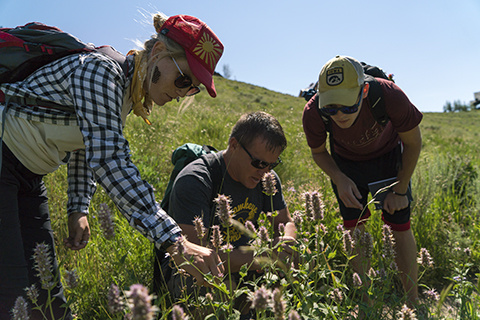
Ted Neal, center, identifies wildflowers with his Geoscience Field Course students.
Just, who is pursuing a Bachelor of Arts in Environmental Sciences, is also in the Master of Arts in Teaching program for science education, and a Noyce Scholar. The scholarship, funded by the National Science Foundation, provides $12,000 per year in support for up to three years for students preparing to be secondary science teachers through either the Masters in Science Teaching (MAT) program or the “4+1” program (BA/MAT), which have a combined total of 20 students. The $1.4 million dollar NSF grant, titled “Encouraging Students to Become Secondary STEM Teachers in Eastern Iowa” will provide 30-40 scholarships over the next five years.
Just says that the course in Colorado has shown her that it’s okay to ask questions as she learns and that her future students should be encouraged to do so, as well. The fact that the course is so hands-on throughout its duration is also a huge benefit to shaping her understanding of teaching in the field.
The course has helped Just see that there are many roles teachers can play in the lives of their students. Teachers can be lecturers, as well as those who lead the charge into the field, sparking questions and collaborative learning among their students.
“We, as students, can challenge ourselves. We’re learning how to teach experiences.”
- Michaela Just
“We, as students, can challenge ourselves,” says Just. “We’re learning how to teach experiences. It means breaking through traditional roles in the classroom and actually doing the experience.”
Changing how they look at learning
Neal has been with the College of Education for eight years and a part of the Geoscience Field Course for the past 10 years. As a student, he participated in the course for two years before taking the lead on the annual excursion to the vast, sweeping mountains of western Colorado. The course, which offers three semester hours of credit with the option for a fourth hour with extra lab work, began nearly 30 years ago thanks to Professor Emeritus John Dunkhase.
“He sat in a room with in-service teachers and said, ‘I can show you slides of Colorado or I can take you to Colorado,’ which was kind of a joke at the time,” says Neal, adding that the course was built soon after that interaction with teachers.
The opportunities for exploring learning theories in the Crested Butte, Colorado area in this course are specialized, says Neal. Students are presented with unique experiences they could not find in other courses, he adds.
Each day at 8 a.m. students begin their field experience, which typically lasts until 6 p.m., with breaks for lunch and rest. This kind of deep immersion in the mountains, valleys, and streams of Colorado allows students to hike along, learning about a singular geology “story” each day, says Neal.
Throughout the week, they venture through areas such as Cement Creek and Black Cannon of the Gunnison National Park, learning first-hand about ancient seaways and how the Rocky Mountains were formed over eons.
“We experience the geology of what happens,” says Neal of their hike through Slate Creek. “It’s a very powerful story for them.”
For Neal, geology is about telling stories – tales of how mountains, streams, meadows, and rivers came to be in their present state. He says teaching these stories is not about expecting students to memorize and regurgitate fact-after-scientific-fact. For both students in his Geoscience Field Course and the students they will teach, this is an engaging teaching method, says Neal.
“That’s what we’re teaching them to do – to get kids engaged and excited and to change how they look at school.”
- Ted Neal
“Say we give them four scraps from a book and then ask them what the story is about,” explains Neal. “That’s geology. We don’t know the whole story. But, we can take bits of the story as evidence to tell a story. That’s what we’re teaching them to do – to get kids engaged and excited and to change how they look at school.”
Trekking toward new teacher terrain
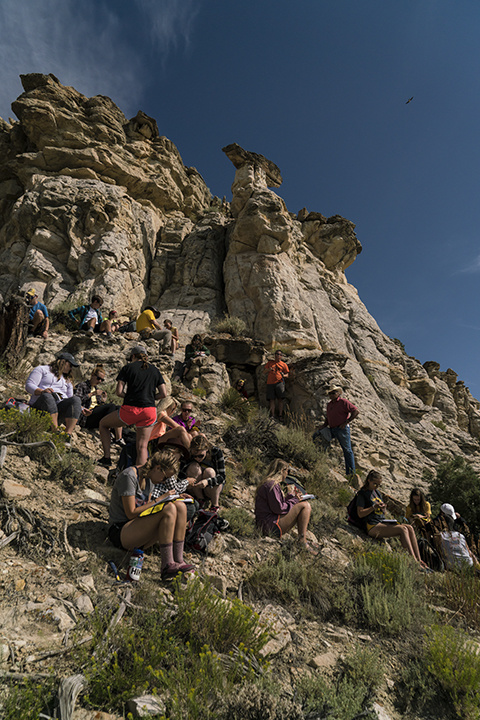
Specimen collecting and lectures in the open
air of Colorado.
Zach Miller, of Bettendorf, Iowa, is one of those students. He knows that strapping on some sturdy footwear and venturing into the mountains of western Colorado has shown him how to teach science to his future students in new and creative ways.
“This will help me bridge the gap between the classroom and the outdoors,” says Miller, who plans to be an earth science teacher in Iowa after graduation.
Teaching scientific concepts in the field is an essential companion method to traditional classroom lectures, notes Miller. He says it provides more context to the concepts being taught and that field experiences are important for students learning geology and many other scientific disciplines. The experience allows him to see, first-hand, how to teach chemistry and biology in the field during his Colorado experience, noting that he and others observed rocks, mountains, and forest life in the splendor that is the Crested Butte area of Colorado.
Miller, a Noyce Scholar seeking his Master of Arts in Science Teaching, says collaborating with many of the 23 students in the course has also shaped his understanding of what it means to teach the sciences.
Observing the way that Neal and other leadership on the trip interact with him and his peers, revealed an impactful teaching method to Miller. He says that seeing Neal ask students a series of questions about what they observe in the field has shown him that collaboration with his fellow students is essential.
This collaborative model of learning will fit well into his future classrooms, says Miller. He adds this method of instruction is the way many careers are moving, and it is important for students to learn in this kind of environment. In Colorado, Miller learned how to deliver this type of instruction because it was being delivered to him by Neal.
“I want them to understand that they can ask questions,” says Miller. “Collaborating with others has been a huge part of this trip because everyone notices something different. Collaborating needs to be stressed more in the classroom because the world is a more collaborative place.”
‘Adventure learning’
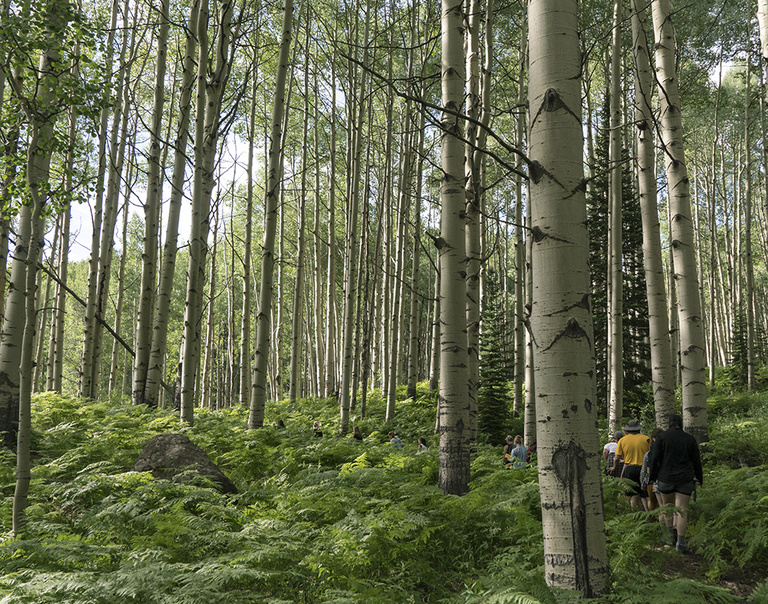
Students hike through an aspen grove’s understory of ferns.
Magdaly Santos-Villalobos, of Ciales, Puerto Rico, is another Noyce Scholar who braved the trails and pathways of the Crested Butte, Colorado countryside for this course. She is pursuing a Master of Science in Science Education, as well as physics and English as a second language endorsements.
Santos-Villalobos decided she wanted to teach science after a career working as a project engineer in Puerto Rico. She had experience working with mostly construction and electrical projects, but really wanted to teach science in a secondary education environment. She decided that she could not pass up the opportunity to participate in the Geoscience Field Course after Neal described it as an “adventure type of learning.”
“What a way to not just learn geology, but also to be there and be hands-on,” says Santos-Villalobos. “It’s more than you would expect. It’s amazing.”
This way of learning is like nothing Santos-Villalobos has ever experienced. She truly appreciates the fact that she’s able to literally hold pieces of history in her hands and learn about this history in the “story” format Neal is so good at telling.
The course has shown Santos-Villalobos how she will be able to shape the curriculums in her future classrooms. She says that not only has she seen the importance of telling stories as you teach, but that there is value in showing students that understanding environmental science is like putting a puzzle together.
“It is invaluable for every teacher,” says Santos-Villalobos of the teaching techniques she’s learned in Colorado. “I would encourage anyone going into science education to take it.”
Read more from the 2016-17 College of Education Annual Report.
